PassLeader 2V0-622PSE Exam Dumps Collection with VCE and PDF (Question 181 – Question 210)
100% valid 2V0-622PSE exam questions from PassLeader 2V0-622PSE dumps! Welcome to download the newest & 100% pass guarantee PassLeader 2V0-622PSE VCE and PDF dumps: https://www.passleader.com/2v0-622pse.html (375 Q&As)
P.S. Free & New 2V0-622PSE dumps are available on Google Drive shared by PassLeader: https://drive.google.com/open?id=0B-ob6L_QjGLpaXhnQWQ4S2Ffc1k
QUESTION 181
Which two scenarios would cause a Fault Tolerance-enabled virtual machine to fail to power the Secondary virtual machine? (Choose two.)
A. The host has entered a Network Partitioned state.
B. vSphere High Availability (HA) is disabled on the host cluster.
C. Enhanced vMotion Compatibility (EVC) is enabled on the host cluster.
D. vSphere Distributed Power Management (DPM) is enabled on the host cluster.
Answer: AB
QUESTION 182
An administrator is reviewing a vSphere Distributed Resource Scheduler (DRS) enabled Cluster and observes unexpected behavior as shown in the exhibit:
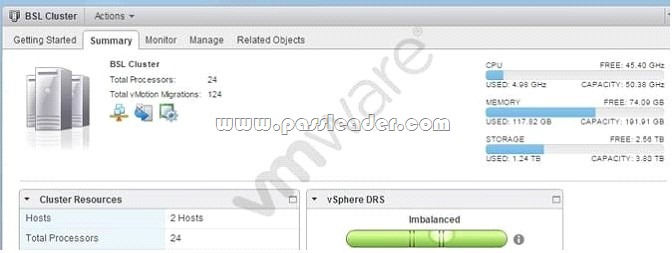
What are three potential causes of the cluster imbalance? (Choose three.)
A. A local device is mounted to one or more virtual machines.
B. DRS rules prevent virtual machines from being moved.
C. vMotion is not configured and enabled.
D. There are insufficient cluster resources to perform the migration.
E. DRS has been configured for a conservative migration threshold.
Answer: ABC
QUESTION 183
An administrator receives vRealize Operations alerts for the Health of the virtual machine PVMAPP_0 as shown in exhibit 1. The administrator clicks on the Analysis pane, as shown in exhibit 2:
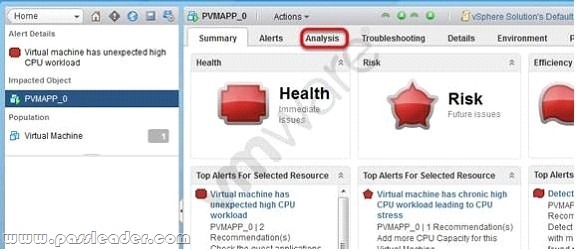
Based on the exhibits, what action would correctly address the performance problems observed?
A. Increase the number of vCPUs for PVMAPP_0.
B. Increase the allocation of memory for PVMAPP_0.
C. Increase the Memory limit for PVMAPP_0.
D. Increase the reservation in MHz for vCPUs for PVMAPP_0.
Answer: A
QUESTION 184
Which two identification sources can a vSphere Auto Deploy rule use to identify target hosts? (Choose two.)
A. Processor Serial Number
B. Security Identifier
C. SMBIOS information
D. BIOS UUID
Answer: CD
QUESTION 185
An administrator has decided to create 10 ESXi 6.x hosts via Auto Deploy for a new Test/Dev cluster. The hosts are configured to obtain their networking configuration via DHCP. Which Direct Console User Interface option should the administrator use to renew the DHCP lease for the hosts?
A. Restore Network Settings
B. Test Management Network
C. Restart Management Network
D. Network Restore Options
Answer: C
QUESTION 186
An administrator is deploying ESXi 6.x hosts using Auto Deploy and wants the image profile to be available, even after closing and opening a new PowerCLI window. Which command can be used to ensure that image profiles are preserved across PowerCLI sessions?
A. Set-EsxImageProfile
B. Export-EsxImageProfile
C. Save-EsxImageProfile
D. Preserve-EsxImageProfile
Answer: B
QUESTION 187
Which two are valid compliance results that indicate the need to apply a Host Profile? (Choose two.)
A. Non-compliant
B. Inconsistent
C. Unknown
D. Disconnected
Answer: AC
QUESTION 188
An administrator is using Auto Deploy to create several ESXi 6.x hosts that will be connected to a vSphere Distributed Switch. After the hosts are deployed, the administrator notices that LACP packets are not being sent between them. Which statement best describes why this issue is occuring?
A. LACP is not enabled on the vCenter Server.
B. The LACP support settings do not exist in the host profile.
C. The LACP installation bundle is not included in the image profile.
D. LACP has not been configured on the Auto Deploy server.
Answer: B
QUESTION 189
An administrator plans to use VMware Converter Standalone to convert a virtual machine to a vSphere environment. The source virtual machine has these properties:
– Running Windows 2008 R2
– Contains one NTFS formatted volume
During conversion, how many virtual disks can the administrator add to the destination virtual machine?
A. 0
B. 1
C. 2
D. 3
Answer: A
QUESTION 190
An administrator needs to migrate a legacy physical application server to a virtual machine within a vSphere 6 cluster. As part of the conversion, the administrator must reduce the size of the virtual disks. What action should the administrator take to create a virtual machine with smaller virtual disks than the original physical server?
A. Shut down the physical server and use VMware Converter cold cloning with volume-based cloning at the disk level.
B. Use VMware Converter hot cloning with volume-based cloning at the block level.
C. Shut down the physical server and use VMware Converter cold cloning with volume-based cloning at the file level.
D. Use VMware Converter hot cloning with volume-based cloning at the file level.
Answer: D
QUESTION 191
An administrator needs to recover disk space on a previously-used thin provisioned virtual disk. The volumes where the administrator needs to recover the disk blocks are on VAAI-compliant storage arrays. Which two actions should the administrator take accomplish this task? (Choose two.)
A. Perform a Storage vMotion to another volume in order to force free space recovery to occur.
This recreates the volume in a new location and recovers all unused space.
B. Use VMware Converter to migrate the virtual machine to a new datastore.
This will recreate the volumes and recover all unused space.
C. Issue the vmkfstools -vmfs unmap command within the VMFS volume directory on the ESXi host console.
D. Execute the esxcli storage vmfs unmap command.
Answer: BD
QUESTION 192
A vSphere 6.x DRS cluster is configured as shown in the exhibit:
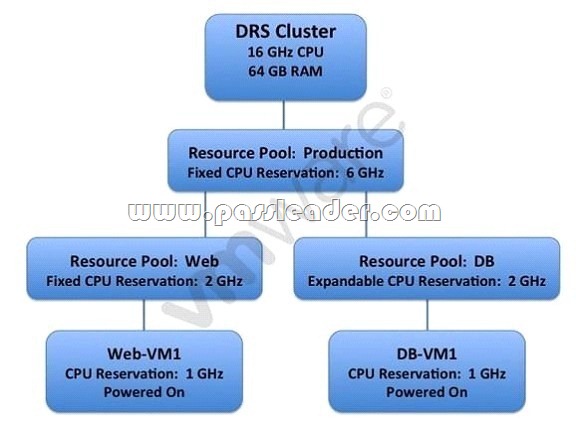
Based on the exhibit, which statement is true?
A. A virtual machine can be powered on in the Web Resource Pool with a 3 GHz CPU Reservation.
B. A virtual machine can be powered on in the Web Resource Pool with a 4 GHz CPU Reservation.
C. A virtual machine can be powered on in the DB Resource Pool with a 3 GHz CPU Reservation.
D. A virtual machine can be powered on in the DB Resource Pool with a 4 GHz CPU Reservation.
Answer: C
QUESTION 193
An administrator wants to set a non-default isolation address of 192.168.1.2 for High Availability. Which advanced setting would accomplish this task?
A. Das.isolationaddress0=192.168.1.2
B. Das.useisolationaddress0=192.168.1.2
C. Das.defaultisolationaddress0=192.168.1.2
D. Das.haisolationaddress0=192.168.1.2
Answer: A
QUESTION 194
How does vSphere High Availability calculate the memory slot size of a virtual machine?
A. Virtual machine memory reservation + overhead of largest virtual machine
B. Virtual machine memory reservation – overhead of largest virtual machine
C. Virtual machine memory reservation + overhead of smallest virtual machine
D. Virtual machine memory reservation – overhead of smallest virtual machine
Answer: A
QUESTION 195
An administrator receives the error message shown in the exhibit:

Which two actions can be taken to clear the warning? (Choose two.)
A. Add a Virtual SAN datastore and configure it for High Availability heartbeating.
B. Set the advanced High Availability parameter Das.heartbeatdsperhost to 1.
C. Set the advanced High Availability parameter Das.ignoreInsufficientHbDatastore to true.
D. Add a shared datastore and reconfigure High Availability.
Answer: CD
QUESTION 196
In a vSphere High Availability cluster, what is the VM Monitoring I/O stats interval default value?
A. 60 seconds
B. 90 seconds
C. 120 seconds
D. 180 seconds
Answer: C
QUESTION 197
An administrator enables High Availability (HA) on a Virtual SAN cluster. There are four vmkernel port groups with the following IP addresses assigned:
– Management: 192.168.12.10
– vMotion: 192.168.13.10
– Virtual SAN: 192.168.14.10
– Fault Tolerance: 192.168.15.10
Which IP address will HA use for traffic?
A. 192.168.12.10
B. 192.168.13.10
C. 192.168.14.10
D. 192.168.15.10
Answer: C
QUESTION 198
An administrator wants to configure a High Availability cluster to allow virtual machines a 10 minute window to shut down in the event of a Host Isolation incident. What two configuration settings would satisfy this requirement? (Choose two.)
A. Set the advanced option das.isolationshutdowntimeout = 10.
B. Set the advanced option das.isolationshutdowntimeout = 600.
C. Configure Host Isolation Response to Shut Down and Restart VMs.
D. Configure Host Isolation Response to Power Off and Restart VMs.
Answer: BC
QUESTION 199
A vSphere 6 High Availability cluster has been configured with default settings. Four virtual machines in the cluster have been configured with these priorities:
– Prod-DB: High
– Prod-Email: High
– Prod-VC: Medium
– Dev-VDI: Low
How many VM Overrides would need to be defined at the cluster level to meet the restart priorities?
A. 1
B. 2
C. 3
D. 4
Answer: B
QUESTION 200
Which two settings are required for Virtual Machine Component Protection (VMCP) to protect from All Paths Down (APD) and Permanent Device Loss (PDL)? (Choose two.)
A. Host Monitoring
B. VM Restart Priority
C. Virtual machine Monitoring
D. Response for Host Isolation
Answer: AB
QUESTION 201
Which two options are available in the Virtual Machine Component Protection (VMCP) setting Response for Datastore with All Paths Down (APD)? (Choose two.)
A. Issue Events
B. Power off and restart virtual machines
C. Reset virtual machines
D. Leave Powered On
Answer: AB
QUESTION 202
Which two statements regarding Distributed Resource Scheduler (DRS) affinity rules are true? (Choose two.)
A. When two VM-VM affinity rules conflict, the older one takes precedence and the newer rule is disabled.
B. Using Specify Failover Hosts admission control policy, VM-VM affinity rules are not supported.
C. DRS gives higher precedence to preventing violations of anti-affinity rules than violations of affinity rules.
D. It is not possible to create an affinity rule that conflicts with the other rules being used.
Answer: AC
QUESTION 203
An administrator has configured Distributed Resource Scheduler (DRS) groups and Affinity Rules as shown in the exhibit:
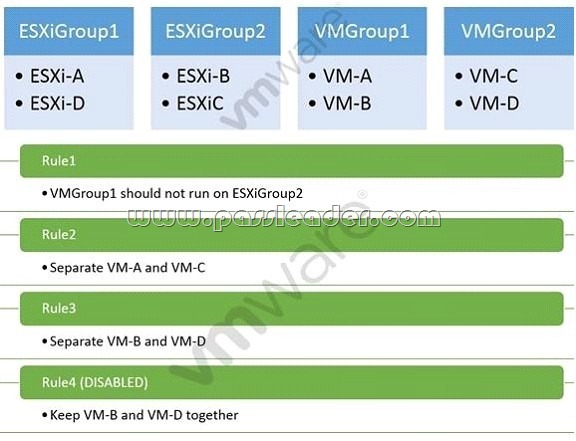
Based on the exhibit, which two statements are true? (Choose two.)
A. If ESXi-A and ESXi-D failed, VM-A and VM-B would not failover.
B. A new conflicting affinity rule will be disabled by default.
C. VM-B and VM-D can run on the same hosts.
D. The administrator must disable Rule3 in order to enable Rule4.
Answer: BD
QUESTION 204
An administrator wants to prevent a priority virtual machine that resides in a vSphere DRS cluster from migrating to other hosts in the cluster. What configuration step will accomplish this without affecting other virtual machines?
A. Set VM Overrides to Partially Automated.
B. Set VM Overrides to Manual.
C. Configure a VM/Host Rule with the setting Must run on hosts in group.
D. Configure a VM/Host Rule with the setting Should run on hosts in group.
Answer: B
QUESTION 205
The Prod-DB virtual machine has a VM Override as shown in the exhibit:

What step, it taken, would require all virtual machines in the cluster to migrate automatically?
A. Deselect the virtual machine from VM Overrides.
B. Add all virtual machines to the VM Overrides.
C. Change Response for Host Isolation to Use Cluster Settings.
D. Change the Automation level to Use Cluster Settings.
Answer: D
QUESTION 206
An administrator reviews the Health of a virtual machine, as shown in the exhibit:
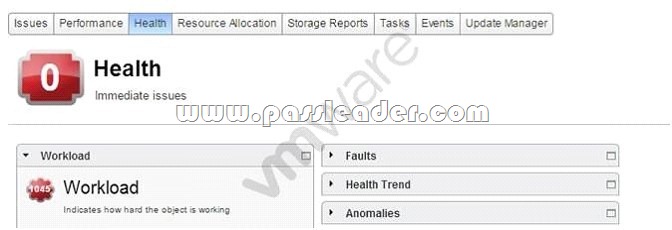
Based on the exhibit, which three metrics can be used to determine the virtual machine’s Workload characteristics? (Choose three.)
A. CPU
B. Memory
C. Network I/O
D. Threads
E. vNUMA Stats
Answer: ABC
QUESTION 207
An administrator wants to increase the capacity of a VMFS5 datastore; but the Increase Size by s lider is not available, as shown in the exhibit:
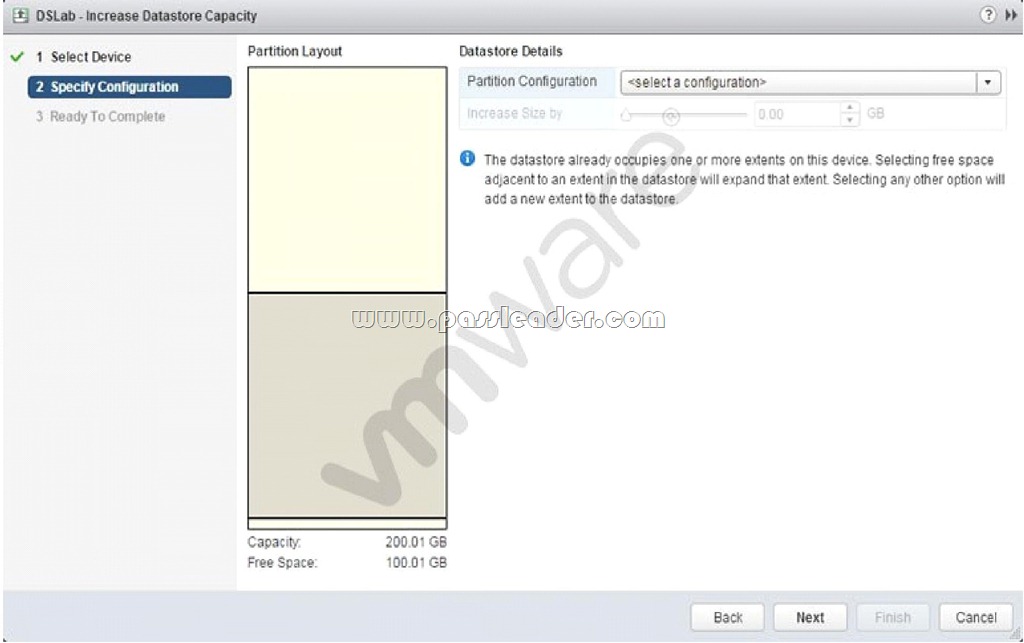
How should the administrator resolve this problem?
A. Select a valid partition configuration from the drop-down menu.
B. Use fdisk utility to manually resize the partition.
C. Use the mouse to resize the partition indicated in the Partition Layout.
D. Clicking Next will prompt for available usable space.
Answer: A
QUESTION 208
An administrator recently created a Virtual SAN but no Storage Policies were defined. A few virtual machines were deployed to this cluster. The administrator analyzes the default Virtual SAN policy as shown in the exhibit:

Based on the exhibit, which two statements are true? (Choose two.)
A. Losing one cluster node will not affect data availability.
B. Losing one Hard Disk in a cluster node will not affect data availability.
C. Creating a virtual machine Swap file will fail if it violates default storage policy.
D. Creating a virtual machine will succeed even if it violates default storage policy.
Answer: AB
QUESTION 209
A Storage Policy for a Virtual SAN is set to the default policy, as shown in the exhibit:
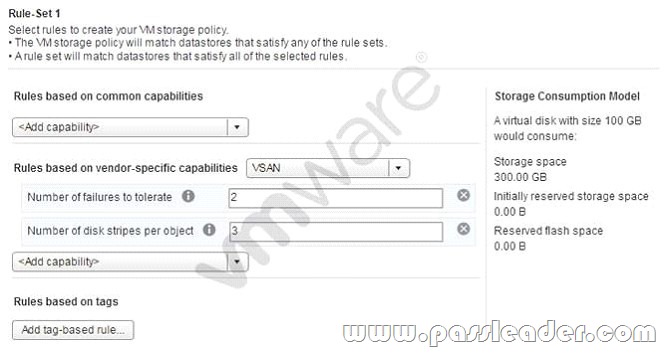
Which change would reduce the storage consumption by one third?
A. Number of failures to tolerate = 1
B. Number of disk stripes per object = 2
C. Number of failures to tolerate = 3
D. Number of disk stripes per object = 1
Answer: A
QUESTION 210
Which tab shows the Hardware Acceleration support status?
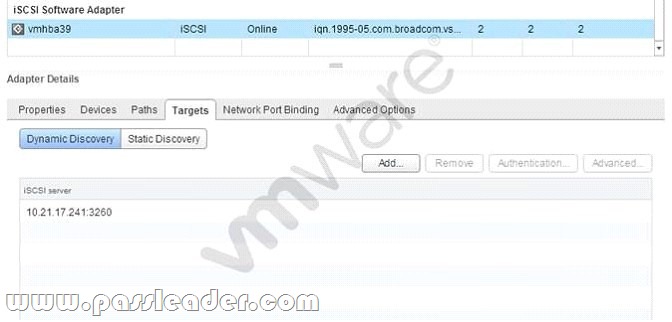
A. Devices
B. Properties
C. Paths
D. Advanced Options
Answer: A
100% valid 2V0-622PSE exam questions from PassLeader 2V0-622PSE dumps! Welcome to download the newest & 100% pass guarantee PassLeader 2V0-622PSE VCE and PDF dumps: https://www.passleader.com/2v0-622pse.html (375 Q&As)
P.S. Free & New 2V0-622PSE dumps are available on Google Drive shared by PassLeader: https://drive.google.com/open?id=0B-ob6L_QjGLpaXhnQWQ4S2Ffc1k